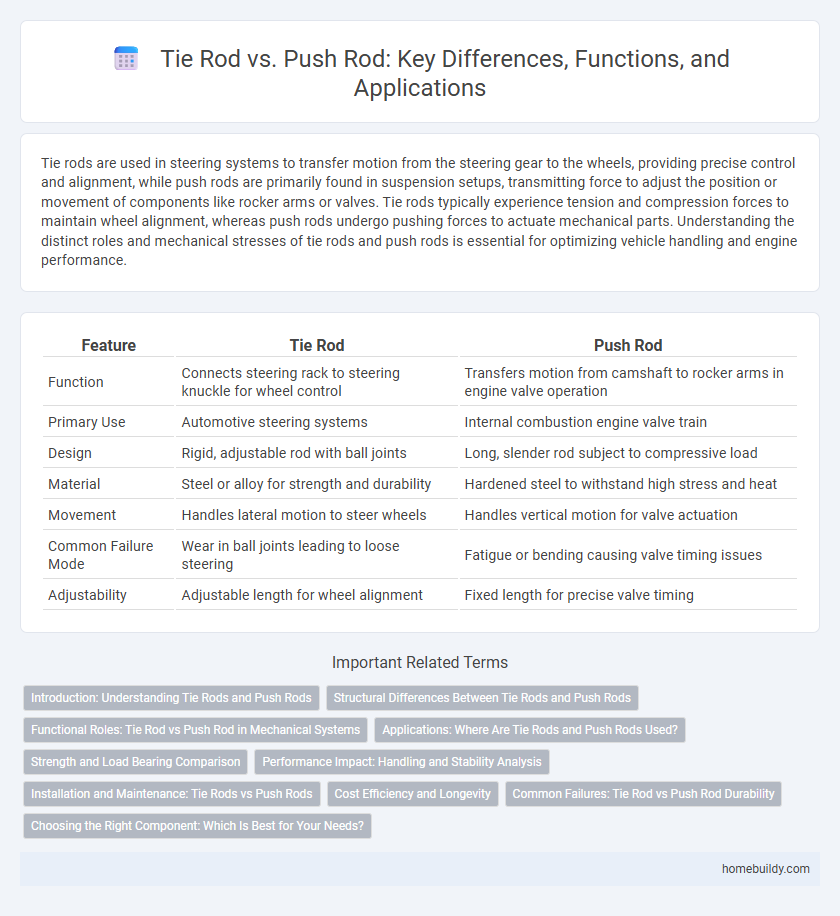Tie rods are used in steering systems to transfer motion from the steering gear to the wheels, providing precise control and alignment, while push rods are primarily found in suspension setups, transmitting force to adjust the position or movement of components like rocker arms or valves. Tie rods typically experience tension and compression forces to maintain wheel alignment, whereas push rods undergo pushing forces to actuate mechanical parts. Understanding the distinct roles and mechanical stresses of tie rods and push rods is essential for optimizing vehicle handling and engine performance.
Table of Comparison
| Feature | Tie Rod | Push Rod |
|---|---|---|
| Function | Connects steering rack to steering knuckle for wheel control | Transfers motion from camshaft to rocker arms in engine valve operation |
| Primary Use | Automotive steering systems | Internal combustion engine valve train |
| Design | Rigid, adjustable rod with ball joints | Long, slender rod subject to compressive load |
| Material | Steel or alloy for strength and durability | Hardened steel to withstand high stress and heat |
| Movement | Handles lateral motion to steer wheels | Handles vertical motion for valve actuation |
| Common Failure Mode | Wear in ball joints leading to loose steering | Fatigue or bending causing valve timing issues |
| Adjustability | Adjustable length for wheel alignment | Fixed length for precise valve timing |
Introduction: Understanding Tie Rods and Push Rods
Tie rods and push rods are essential components in automotive and mechanical systems, serving distinct functions in steering and suspension mechanisms. Tie rods primarily connect the steering knuckle to the steering rack, ensuring precise wheel alignment and responsive steering control. Push rods, often found in suspension systems and internal combustion engines, transfer motion or force from one component to another, playing a crucial role in valve operation or suspension movement.
Structural Differences Between Tie Rods and Push Rods
Tie rods are primarily tension members designed to resist pulling forces, featuring straight, slender rods often equipped with threaded ends for adjustment. Push rods, in contrast, are compression members engineered to withstand pushing forces, typically thicker and more rigid to prevent buckling under load. Structurally, tie rods rely on tensile strength with minimal cross-sectional area, whereas push rods demand greater stiffness and cross-sectional area to maintain stability under compressive stress.
Functional Roles: Tie Rod vs Push Rod in Mechanical Systems
Tie rods primarily function to provide tensile support and maintain alignment in mechanical systems by resisting pulling forces, ensuring structural stability. Push rods, on the other hand, are designed to transmit compressive forces, transferring motion or load through pushing actions in engines and other machinery. Understanding the distinct functional roles of tie rods and push rods is essential for optimizing mechanical system performance and durability.
Applications: Where Are Tie Rods and Push Rods Used?
Tie rods are commonly used in steering and suspension systems of vehicles, providing precise control and stability by linking steering components or supporting suspension arms. Push rods are predominantly found in engine valve trains, especially in overhead valve (OHV) engines, where they transfer motion from the camshaft to the rocker arms. While tie rods excel in applications requiring lateral force transmission, push rods are essential in mechanisms demanding vertical motion transfer within confined engine spaces.
Strength and Load Bearing Comparison
Tie rods offer superior tensile strength compared to push rods, allowing them to effectively handle higher axial loads without deformation. Their design distributes stress evenly along the rod, enhancing load-bearing capacity in tension applications. Push rods, primarily used for compression, have lower resistance to buckling under heavy loads, making tie rods preferable in scenarios demanding robust tensile strength.
Performance Impact: Handling and Stability Analysis
Tie rods provide more precise steering input and quicker response times compared to push rods, significantly enhancing handling and vehicle stability. Their direct connection to the steering knuckle improves feedback and reduces play, which is crucial for high-performance driving and sharp cornering. In contrast, push rods can introduce slight delays and less accurate steering feel, impacting overall handling dynamics negatively.
Installation and Maintenance: Tie Rods vs Push Rods
Tie rods feature straightforward installation with easily accessible adjustment points, facilitating quick alignment and regular maintenance. Push rods often require precise measurement and positioning during installation to ensure proper valve operation, making maintenance more intricate. The simplicity of tie rods reduces downtime and labor costs compared to the more complex push rod systems.
Cost Efficiency and Longevity
Tie rods generally offer higher cost efficiency and longer service life compared to push rods due to their simpler design and easier maintenance requirements. The durable materials used in tie rods contribute to reduced wear and extended operational lifespan, minimizing replacement frequency and overall expenses. Push rods, while effective in specific applications, often incur higher costs over time because of more complex mechanics and increased susceptibility to wear.
Common Failures: Tie Rod vs Push Rod Durability
Tie rods commonly fail due to wear in the ball joints and corrosion from road exposure, leading to steering instability and uneven tire wear. Push rods, primarily used in valve trains, are less prone to external damage but can bend or break under extreme engine stress or improper adjustments. Overall, tie rods require more frequent inspection and replacement compared to push rods, reflecting their critical role in vehicle steering durability.
Choosing the Right Component: Which Is Best for Your Needs?
Tie rods provide precise steering control and durability, making them ideal for automotive suspension systems requiring consistent alignment and handling performance. Push rods, typically used in engine valve trains, convert camshaft motion to valve operation, offering advantages in high-performance or racing engines where compact, efficient designs are critical. Selecting between tie rods and push rods depends on whether steering accuracy or valve timing efficiency is the primary requirement in your mechanical system.
tie rod vs push rod Infographic

 homebuildy.com
homebuildy.com